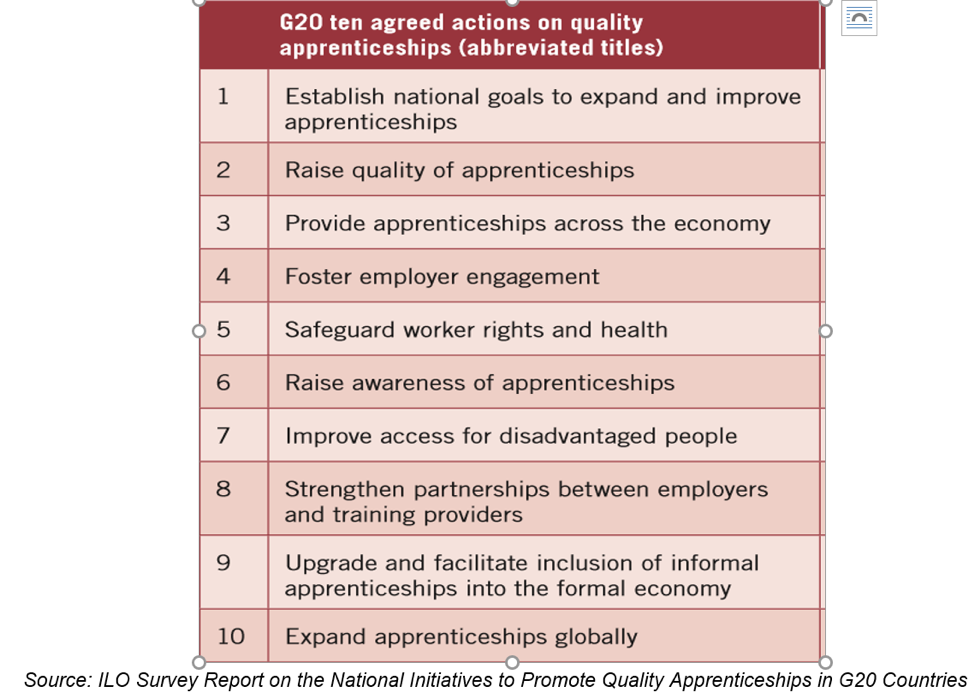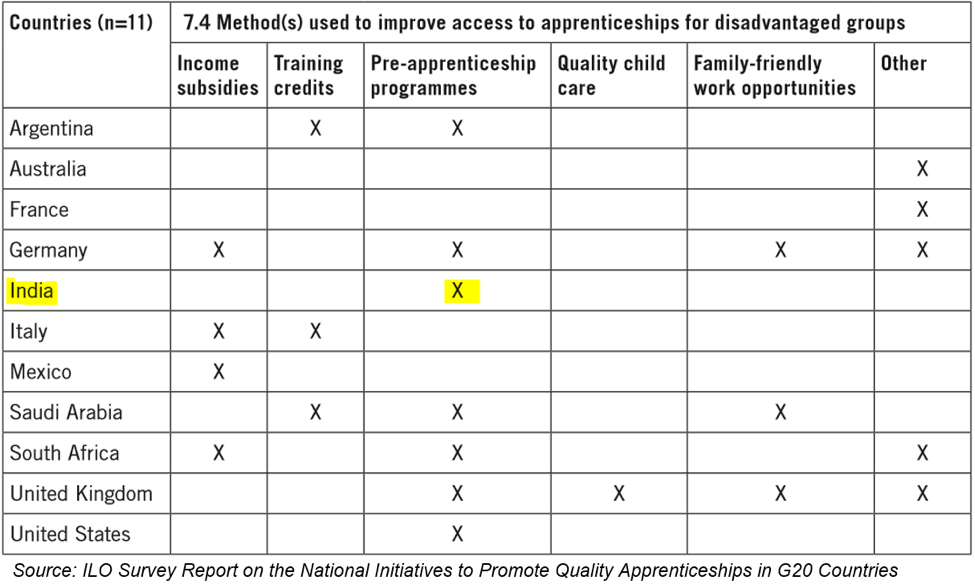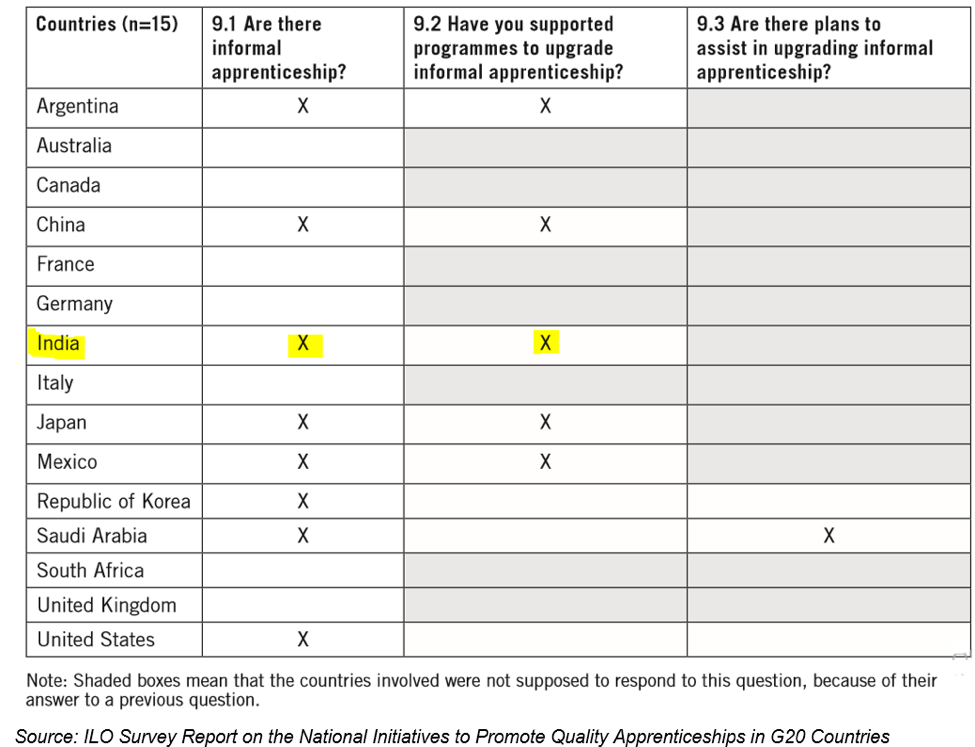This is a continuation from Part I of our series on the above named ILO report.[i] Here, we examine the remaining five of the 10 Action Points of the G20 Initiative to Promote Quality Apprenticeship.


6. Raising the awareness of apprenticeships
Most governments surveyed are actively involved in raising awareness of apprenticeships among four target groups- businesses, career counsellors, jobseekers and the general public. But, personal visits and approaches do not appear to feature high. The exception is the U.K which has a dedicated approach of awareness building for each of the four target groups.
The MSDE reported using dedicated apprenticeship websites, events, leaflets and newspaper advertising. We feel a lot more can be done to ramp up awareness building efforts. For instance, SMEs have specific needs and require a dedicated hand-holding service to navigate the nitty-gritty of the apprenticeship ecosystem. Similarly, career counseling in schools appears to be a key way to target influencers such as teachers and parents.
A generalised approach to awareness building often does not deliver. At a recently held NETAP-India Apprenticeship Forum event a participant pondered, “We thought with the (Apprentice Act) reforms we are well poised to move ahead and to see that industry actually evangelizes apprenticeships. Unfortunately, in the last 3-4 years either we have not been able to communicate the reforms or we have not been able to build the confidence where industry feels it is now time for them to take up apprenticeships. Or there is some information asymmetry in the market.”
7. Improving access to quality apprenticeship for disadvantaged groups
Disadvantaged groups include indigenous people, those from economically backward sections, persons with disabilities and in some cases, women. These groups are commonly provided financial support and mentoring in pre-apprenticeship training to strengthen the chances of program completion.
We are not entirely sure of specific pre-apprenticeship programmes in India. However, a number of skilling schemes targeted at disadvantaged groups may qualify, albeit how these schemes aid a natural transition into an apprenticeship programme is again unclear:
- Deen Dayal Upadhyay Gram Kaushal Yojana
- The Pradhan Mantri Kaushal Vikas Yojana
- Aajeevika- National Rural Livelihood Mission


8. Strengthening partnerships between businesses and vocational schools
The MSDE cited a general approach to building linkages between enterprise and vocational education providers through skills councils or centralised curriculum development initiatives. Our takeaway is that industry needs to be at the helm of curricula design and implementation. A common criticism of skilling initiatives in India is that it is often disjointed from industry demand leading to a severe skills-jobs mismatch. The National Skill Development Agency and the National Skill Development Corporation have in recent years ramped up efforts to engage industry. However, businesses need to be more heavily involved in,
- Local curriculum design and work placements
- Collaborations on projects and research
- Industry representation on governing boards of colleges
- Agreements with colleges for credit transfers from an employer run apprenticeship programme


9. Upgrading informal apprenticeships
Most countries reported a high prevalence of informal apprenticeships. The MSDE cited the “basic training” element of an apprenticeship- theoretical learning provided by Basic Training Providers- as a pathway to upgrade informal apprenticeships. Although there isn’t any credible data on informal apprenticeships in India, we opine that the country has its work cut out if we are to draw conclusions from estimates that around 81% of the workforce make a living in the informal sector[ii] and only around 4% of the workforce have formal vocational skills.[iii]


10. Expanding quality apprenticeship globally
Besides Germany, which is actively involved in promoting apprenticeships worldwide, most other nations have played a participatory role in international apprenticeship events rather than as initiators. Although the MSDE did not respond to the question, we are aware of technical collaborations between India and foreign entities, such as with German development agency, GIZ[iv] on promoting apprenticeships in the country.
Action Points for Policymakers
Notwithstanding the inroads made by the Indian government in flying the apprenticeship flag high, we propose a movement from a generalised approach to more targeted interventions catered to specific groups- vocational education and training providers, different industry groups (SMEs, large firms), career counsellors, youth, and relevant skilling related social groups, in areas such as:
- Building awareness
- Upping industry engagement across the board
- Integrating apprenticeships with formal education
- Improving the quality of training- better curricula, trainers, infrastructure
- Improving mobility pathways between vocational and traditional education
- Increasing the number of pre-apprenticeship programmes and clearly defining what they are
- Specific measures to tackle informal apprenticeships
- Consolidation of certifications and improving the coverage of apprenticed occupations
- Review existing regulation of vocational training to bring in greater transparency, efficiency and flexibility
- Review legal provisions of work and training for an apprentice for improved terms of employment
Stay Tuned
In Part III we look at the influence of other key stakeholders of apprenticeships- employer and worker groups- on the Ten Actions of the G20 Initiative to Promote Quality Apprenticeships.
References
[i] Main source- ILO Survey Report on the National Initiatives to Promote Quality Apprenticeships in G20 Countries, ILO- JPMorgan Chase Foundation, 2018
[ii] Nearly 81% of the Employed in India Are in the Informal Sector: ILO, May 4 2018, The Wire
[iii] Ministry of Skill Development and Entrepreneurship
[iv] Apprenticeship important to produce skilled youth, Aug 6, 2018, Times of India













